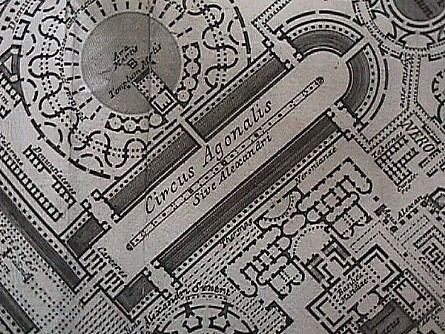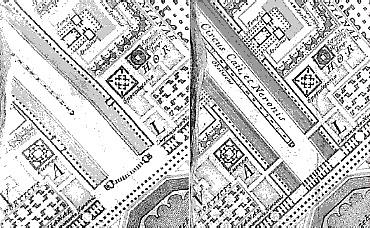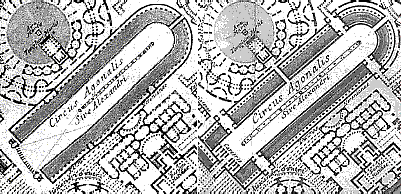Catalogo:
Circo d'Alessandro Aug. «Sesto Rufo nella Reg. IX di Rome» Si riferisce nel cap. 6, art. 13. Ve ne rimangono le vestigie, chi si accennano nella Tav. 2, col num. 24, nella 3, e nell'indice, che cade dopo di essa coi num, 41, 42 e 43. Si dimostrano poi in prospettiva nella Tav. XXXVII.

Circus Agonalis sive Alexandri as delineated within the first state of the Ichnographia Campus Martius.
Stadium Domitiani. The athletic contests of the Greeks were introduced into Rome in the last century of the republic, and Caesar and Augustus erected temporary structures in which they might be held, but Nero seems to have been the first to put up a permanent building. This Gymnasium, as it was called, which was attached to Nero's baths, was regarded as one of the most wonderful edifices in the city. It was struck by lightning and burned to the ground in 62 A.D., and there is no record of its restoration; but the stadium built by Domitian probably occupied the same site. This stadium was restored by Trajan and by Alexander Severus, and was known in the middle ages as the stadium Alexandrinum. It was spoken of in the fourth century as one of the most beautiftil buildings in Rome. Curiously enough, the modern piazza Navona, the longest in the city, preserves almost exactly the shape and size of the stadium of Domitian. The piazza corresponds with the arena of the stadium, the length of which seems to have been about 250 meters, and the surrounding buildings stand on the ruins of the cavea. Under some of these buildings, especially the church of S. Agnese in the middle of the west side, brick and concrete walls and fragments of the travertine seats may still be seen.
(Platner)
Vincenzo Fasolo, "The Campo Marzio of G. B. Piranesi".
2691a
2691c
2691d
1956
Tafuri text
1996.09.02
| |
Ara Martis
1998.04.12
...significance of the Templum and Ara Martis that is situated next to the Circus Agonalis. ...this altar and temple to Mars are representative of the very original altar to Mars from which the entire campus Martius receives its name--indeed this altar is the very first "structure" of the campus.
...now knowing the program of the Alexander Severus complex. ...the porticus providing shade from the heat of the day. ...the temple and altar of Mars is surrounded by a very generous public amenity.
overall, one very Piranesian daze
2000.04.06
...the first documentation of the heretofore undetected two differing published states of Piranesi's Ichnographia Campus Martius, the six fold-out plates that comprise a reenactment plan of ancient Rome within Piranesi's larger Il Campo Marzio dell'antica Roma 'archaeological' publication. After many years of redrawing and analyzing a printed reproduction of the Ichnographia, I went, on May 14, 1999, to see an original version of the Ichnographia at the University of Pennsylvania's Fine Arts Library. Within minutes of having a 'real' Ichnographia unfolded in front of me, I noticed that the Circus of Caligula and Nero is not only labeled, but also configured somewhat differently than the circus plan I was used to seeing. Of course, I was instantly very excited because nowhere have I ever read about the Ichnographia having two editions/states (like Piranesi's Carceri/Prisons have two published states/editions), and these two different plans are definitely not noted within Wilton-Ely's recent Giovanni Battista Piranesi - The Complete Etchings. Moreover, I believe I discovered something that no other architect, architectural historian, or art historian had noticed before. I then quickly scanned the rest of the plan to see if any other differences existed, and, sure enough, the Circus Agonalis is likewise different than the plan commonly reproduced. On 4 April 2000, I finally returned to Penn's Fine Arts Library to document the two different Ichnographia via tracings and taking digital images:

The image above left is the Circus of Caligula and Nero as the Ichnographia is commonly reproduced. The image above right is the Circus of Caligula and Nero as it appears within the University of Pennsylvania's (original) copy of the Campo Marzio.

The image above left is the Circus Agonalia as the Ichnographia is commonly reproduced. The image above right is the Circus Agonalia as it appears within the University of Pennsylvania's (original) copy of the Campo Marzio.
The differing plans raise several questions:
Did Piranesi himself make these changes, or did perhaps his son Francesco, and if Piranesi made them, then why?
Which set of plans were 'drawn' first?
Does this 'change of plan' carry any possible semiotic or symbolic message regarding the Ichnographia's larger meaning?
Does this physical evidence offer any indication of Piranesi's 'design' method?
|